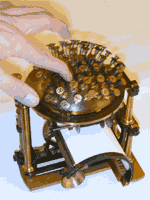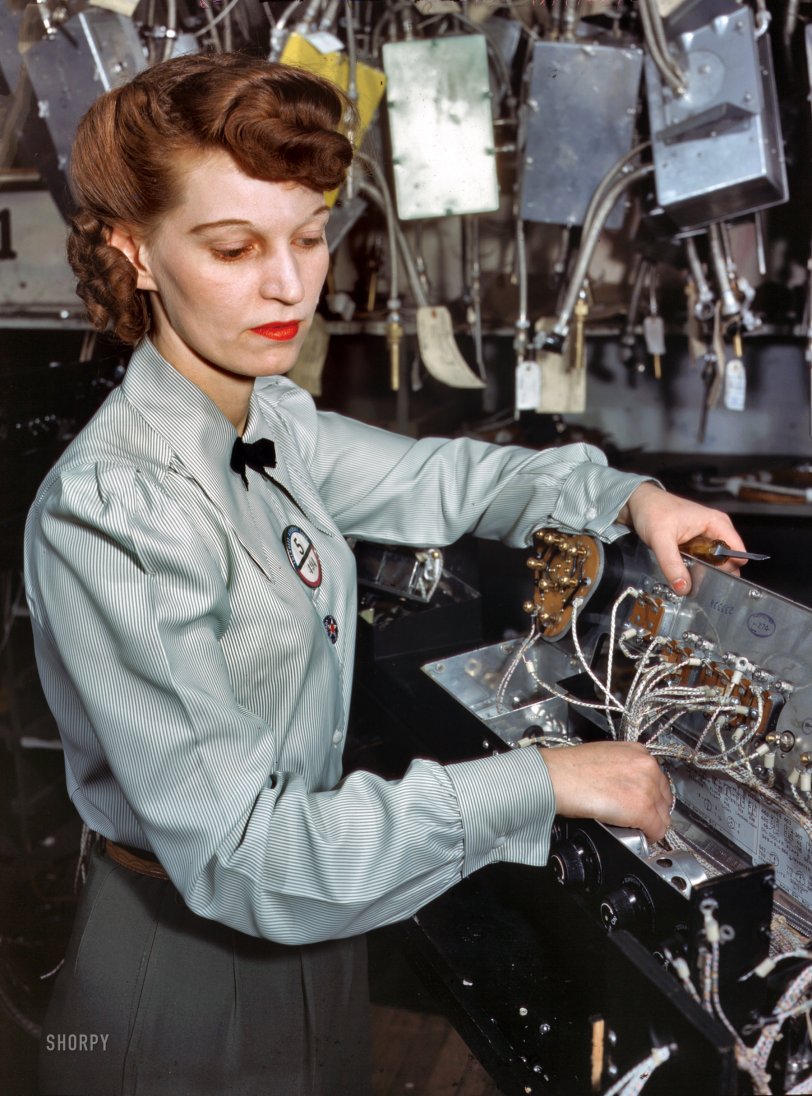Joseph Goebbels meets teenage Volkssturm soldier at Lauban, Lower Silesia, in March 1945
New York City circa 1900. "Shipping at East River docks." More maritime Manhattan. 8x10 glass negative, Detroit Publishing Co. View full size
New York circa 1912. "West Street north from the Battery." An amazing view of the Hudson River piers from the foot of Manhattan centered by the West Street Building, which sustained grave damage a decade ago when the south tower of the World Trade Center collapsed; to east is the massive Hudson Terminal, and faintly visible through the haze is the Metropolitan Life tower. Note the ant-like
November 1909. "Some of night shift waiting to go to work. Cumberland Glass Works, Bridgeton, New Jersey. One boy is 13 years old." And then we have the operator on the left. Photograph by Lewis Wickes Hine. View full size
November 1909. "Some of night shift waiting to go to work. Cumberland Glass Works, Bridgeton, New Jersey. One boy is 13 years old." And then we have the operator on the left. Photograph by Lewis Wickes Hine. View full size.
New York circa 1912. "West Street (11th Avenue) north from 26th, view of Hudson River." As well as the Chelsea Piers and fluttering banner atop the Otis Elevator building. 8x10 glass negative, Detroit Publishing Co. View full size.
 December 1941. "Electronics technician, Goodyear Aircraft Corp., Akron, Ohio." 4x5 Kodachrome transparency by Alfred Palmer, OWI. View full size.
December 1941. "Electronics technician, Goodyear Aircraft Corp., Akron, Ohio." 4x5 Kodachrome transparency by Alfred Palmer, OWI. View full size.
Beautiful Typewriters From 'The Good Old Days'Horse and buggies, hoop skirts, steam engines, bustles ... oh, yes, life around the turn of the previous century was a delight of simplicity and workmanship. But that doesn't mean that the artisans and engineers of way-back-when didn’t at least have their hearts and minds in the right place.

(images via The Typewriter Museum)

(images via Office Museum)
The 1890 Victor: "Take a letter, Miss Jones."

(images via Office Museum)
The Writing Ball That Will Warp and Enchant Your Mind
In 1865 what many consider to be the true ancestor to true, efficient, and financially successful typewriter was developed by Rasmus Malling-Hansen: The Writing Ball. Not only was it efficient, but also strangely elegant, even beautiful: just look at it - a brass half-sphere covered with keys above a cylinder that held the paper. It was finely made, unlike some of the unsuccessful machines before, looking more like a gentleman's watch than a piece of office equipment:

(image credit: Auction Team Koln, via)
The Malling-Hansen Writing Ball: not only one of the first commercial typewriters but also one of the most elegant (more pics and auction price info):

(images credit: Auction Team Koln, via The Malling-Hansen Society)
The Beauty of the Ball - It may have been difficult to use but it sure looked good on your desk:

(image credit: Auction Team Koln, via)
An Illustration of the Malling-Hansen Writing Ball: a lovely etching of the typewriter ball by Hans Gerhard Blodorn - buy a copy here

(image credit: Hans Gerhard Blodorn)
More pretty pictures of Hansen's lovely creation at The Typewriter Museum:

(images credit: The Typewriter Museum)
Sure, Hansen's Ball had some rather serious flaws – like the fact that it was hardly cheap and, because of the position of the ball and the paper under it, the typist really couldn't see what they were typing until they were done and the paper was removed from the machine -- but that didn't stop it from selling better than many other previous models. One quirk of the ball was that, unlike the QWERTY keyboard that pretty much every typewriter after it had and every computer now has, the ball's keys had been positioned to make typing easier for the typist and not the typewriter.
The Sad, Strange Story of QWERTY
By the way, in case you don't know the sad, strange story of QWERTY – which haunts us to this day -- the alphabet were originally put in that order because otherwise users would type faster than the machine could handle, thus jamming the keys. So QWERTY was created to keep that from happening: to keep the machine happy at the cost of typist efficiency.
Here's a fun bit of trivia for you folks now interested in Malling-Hansen's elegant writing ball: one particular person was interested in this new, wondrous invention – a celebrated writer who was having a hard time with his diminishing eyesight. While Nietzsche did get and use his writing ball he sadly didn't love it – though it is fascinating to visualize the author of Thus Spoke Zarathustra clicking and clacking on the mechanical beauty of one of Hansen's creations.

Balls Of Every Shape And Size
Hansen didn't stop with his first creation. Over the years after the release of his first ball he created a whole range of machines with all kinds of variations:
A handsome selection of Malling-Hansen Writing Balls, including a lovely one in a wooden case can be found at The Malling-Hansen Society -

The Miniature Writing Ball (more info and pictures here):

(images via)
The cryptographic writing ball by Alexis Kohls, circa 1883 -

Another fascinating keyboard variation: The Piano-style Keyboard - American-made Hammond from 1880:

(image via)
Eventually, though, other – and cheaper – machines were developed, saving generations of writers, secretaries, business people, and anyone else who used to have to put pen to paper, from cramp and bad handwriting. Though Hansen and his elegant ball have been almost lost to time it's nice to be able to show a new, QWERTY-slaved generation, the beauty of his creation.


Coney Island looking east from Steeplechase Pier showing Sunday bathers, crowd on beach, on July 30, 1922. (Rutter, Edward E./Courtesy NYC Municipal Archives
The New York City Municipal Archives just released a database of over 870,000 photos from its collection of more than 2.2 million images of New York throughout the 20th century. Their subjects include daily life, construction, crime, city business, aerial photographs, and more. I spent hours lost in these amazing photos, and gathered this group together to give you just a glimpse of what's been made available from this remarkable collection. [53 photos]

Beautiful Typewriters From 'The Good Old Days'Horse and buggies, hoop skirts, steam engines, bustles ... oh, yes, life around the turn of the previous century was a delight of simplicity and workmanship. But that doesn't mean that the artisans and engineers of way-back-when didn’t at least have their hearts and minds in the right place.

(images via The Typewriter Museum)

(images via Office Museum)
The 1890 Victor: "Take a letter, Miss Jones."

(images via Office Museum)
The Writing Ball That Will Warp and Enchant Your Mind
In 1865 what many consider to be the true ancestor to true, efficient, and financially successful typewriter was developed by Rasmus Malling-Hansen: The Writing Ball. Not only was it efficient, but also strangely elegant, even beautiful: just look at it - a brass half-sphere covered with keys above a cylinder that held the paper. It was finely made, unlike some of the unsuccessful machines before, looking more like a gentleman's watch than a piece of office equipment:

(image credit: Auction Team Koln, via)
The Malling-Hansen Writing Ball: not only one of the first commercial typewriters but also one of the most elegant (more pics and auction price info):

(images credit: Auction Team Koln, via The Malling-Hansen Society)
The Beauty of the Ball - It may have been difficult to use but it sure looked good on your desk:

(image credit: Auction Team Koln, via)
An Illustration of the Malling-Hansen Writing Ball: a lovely etching of the typewriter ball by Hans Gerhard Blodorn - buy a copy here

(image credit: Hans Gerhard Blodorn)
More pretty pictures of Hansen's lovely creation at The Typewriter Museum:

(images credit: The Typewriter Museum)
Sure, Hansen's Ball had some rather serious flaws – like the fact that it was hardly cheap and, because of the position of the ball and the paper under it, the typist really couldn't see what they were typing until they were done and the paper was removed from the machine -- but that didn't stop it from selling better than many other previous models. One quirk of the ball was that, unlike the QWERTY keyboard that pretty much every typewriter after it had and every computer now has, the ball's keys had been positioned to make typing easier for the typist and not the typewriter.
The Sad, Strange Story of QWERTY
By the way, in case you don't know the sad, strange story of QWERTY – which haunts us to this day -- the alphabet were originally put in that order because otherwise users would type faster than the machine could handle, thus jamming the keys. So QWERTY was created to keep that from happening: to keep the machine happy at the cost of typist efficiency.
Here's a fun bit of trivia for you folks now interested in Malling-Hansen's elegant writing ball: one particular person was interested in this new, wondrous invention – a celebrated writer who was having a hard time with his diminishing eyesight. While Nietzsche did get and use his writing ball he sadly didn't love it – though it is fascinating to visualize the author of Thus Spoke Zarathustra clicking and clacking on the mechanical beauty of one of Hansen's creations.

Balls Of Every Shape And Size
Hansen didn't stop with his first creation. Over the years after the release of his first ball he created a whole range of machines with all kinds of variations:
A handsome selection of Malling-Hansen Writing Balls, including a lovely one in a wooden case can be found at The Malling-Hansen Society -

The Miniature Writing Ball (more info and pictures here):

(images via)
The cryptographic writing ball by Alexis Kohls, circa 1883 -

Another fascinating keyboard variation: The Piano-style Keyboard - American-made Hammond from 1880:

(image via)
Eventually, though, other – and cheaper – machines were developed, saving generations of writers, secretaries, business people, and anyone else who used to have to put pen to paper, from cramp and bad handwriting. Though Hansen and his elegant ball have been almost lost to time it's nice to be able to show a new, QWERTY-slaved generation, the beauty of his creation.


Coney Island looking east from Steeplechase Pier showing Sunday bathers, crowd on beach, on July 30, 1922. (Rutter, Edward E./Courtesy NYC Municipal Archives
The New York City Municipal Archives just released a database of over 870,000 photos from its collection of more than 2.2 million images of New York throughout the 20th century. Their subjects include daily life, construction, crime, city business, aerial photographs, and more. I spent hours lost in these amazing photos, and gathered this group together to give you just a glimpse of what's been made available from this remarkable collection. [53 photos]




























































